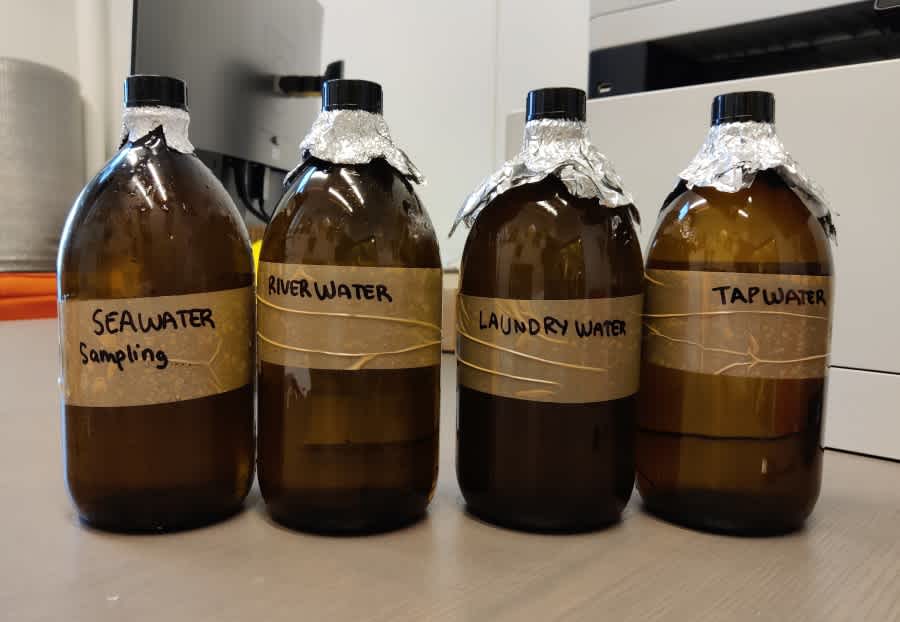The exponential growth of plastic usage in the past decades has translated into heaps of waste on beaches and roadsides – and countless infinitely small microplastic particles in the natural environment.
To compare microplastic concentrations in different types of water, we sent the following samples to be analyzed:
River water from the Vantaa river
Seawater from the Baltic sea
Tap water from our office in Helsinki
Bottled drinking water
Laundry water (greywater) collected through the washing machine drain hose
Bottled water was delivered to the laboratory in its original packaging. Other samples were collected in glass bottles, and foil was placed between the plastic cap and the sample to prevent contamination. The samples were analyzed using Raman spectroscopy, which can identify and classify microplastic particles based on plastic-type and particle size range.

The highest microplastic concentration was observed in laundry water
During the analysis, microplastics were discovered in each of the five samples. The number, sizes, and types of particles varied considerably between water types, however. Figure 1 shows the particles detected in each sample. The results are expressed as the number of particles per liter.

By a considerable margin, the largest number of microplastics was discovered in laundry water, which contained 1,040 polyethylene particles and 400 polypropylene particles. The microplastic concentration of bottled water was the second highest with 32 polyethylene, 6 polypropylene, and 2 polystyrene particles.
Seawater contained 24 polyethylene particles per liter, while river water only contained 4 polystyrene and 8 polypropylene particles. The smallest number of microplastics was detected in tap water, which contained a total of 10 polystyrene particles in two different size ranges.
The smallest particles are the most likely to end up in the natural environment
Measurlabs’ environmental analysis expert Aatto Rautio does not consider the high microplastic concentration of laundry water surprising, as textiles composed of synthetic fibers release microplastic particles during laundering. Polyethylene is also the most common type of plastic worldwide and is widely used in packaging materials for laundry detergents and other consumer products.
In addition to the number of particles, Rautio pays attention to their size range.
“It is important to note that all the microplastic particles found in the laundry water were between 1 and 50 µm in size. These particles have a great chance of ending up in waterways and nature, as removing the smallest particles from wastewater can be challenging.”
Bottled water drinkers are exposed to higher concentrations of microplastics
The results of the analysis show that bottled water contains considerably more microplastic particles than tap water. The difference is especially pronounced in the smallest size range, as bottled water mostly contains particles measuring less than 50 µm. These smallest particles are the ones causing the most concern, as studies have demonstrated that they are most likely to accumulate in the body.
“As only one bottled water was analyzed in the test, we cannot draw far-reaching conclusions from this result. Previous studies do point in the same direction, however, as bottled water has been shown to contain considerable amounts of microplastics,” Aatto Rautio notes.
The expert emphasizes the need for further analysis of both microplastic concentrations and their prospective sources.
“This test does not provide enough data to conclude where the plastic particles originate. When it comes to bottled water, it would be interesting to study whether microplastics end up in the water from the empty bottles, the caps, from different stages of the bottling process, or the water itself,” Rautio says.
Research should focus on the smallest plastic particles
As just one sample per water type was analyzed in this experiment, more research is needed to draw definitive conclusions about the differences in microplastic concentrations. Statistically significant results would require the analysis to be repeated with at least dozens of samples. Regardless, it does seem clear that microplastics are found in all types of water, including the water we drink.
Rautio concludes the analysis with the note that only particles in the micrometer size range were studied, with most discovered particles falling into the 1–50 µm category. Larger, 500 µm+ plastic pieces were not discovered in any of the samples.
“This highlights the need to make sure that even the smallest particles can be analyzed effectively in similar studies. Based on the results, it is completely reasonable to assume that the samples contain even smaller particles with a diameter of less than 1 µm. These so-called nanoplastics are more difficult to study, but undoubtedly warrant more attention.”

